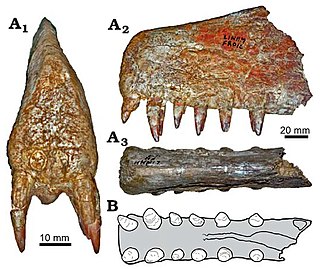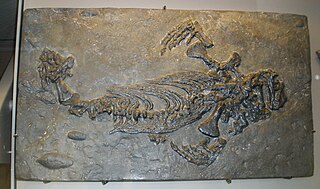
Thuja is a genus of coniferous trees or shrubs in the Cupressaceae. There are five species in the genus, two native to North America and three native to eastern Asia. The genus is monophyletic and sister to Thujopsis. Members are commonly known as arborvitaes, thujas or cedars.

Semionotiformes is an order of primitive, ray-finned, primarily freshwater fish from the Middle Triassic (Anisian) to the Late Cretaceous (Maastrichtian). The best-known genus is Semionotus of Europe and North America. Their closest living relatives are gars (Lepisosteidae), with both groups belonging to the clade Ginglymodi within the Holostei.

Flying squirrels are a tribe of 50 species of squirrels in the family Sciuridae. Despite their name, they are not in fact capable of full flight in the same way as birds or bats, but they are able to glide from one tree to another with the aid of a patagium, a furred parachute-like skin membrane that stretches from wrist to ankle. Their long tails also provide stability as they glide. Anatomically they are very similar to other squirrels with a number of adaptations to suit their lifestyle; their limb bones are longer and their hand bones, foot bones, and distal vertebrae are shorter. Flying squirrels are able to steer and exert control over their glide path with their limbs and tail.
Araripesaurus was a pterosaur belonging to the suborder Pterodactyloidea, it was discovered in the Romualdo Formation of the Santana Group in northeastern Brazil, which dates back to the Aptian and Albian of the Early Cretaceous. The type species is A. castilhoi.
Brasileodactylus a genus of pterosaur from the Aptian-age lower Santana formation of Chapada do Araripe, Ceará, Brazil.

Siroccopteryx is an extinct genus of anhanguerid pterodactyloid pterosaur, known from middle Cretaceous sediments in modern-day Morocco. Some researchers, such as David M. Unwin, consider the genus a junior synonym of Coloborhynchus.

Carcinosoma is a genus of eurypterid, an extinct group of aquatic arthropods. Fossils of Carcinosoma are restricted to deposits of late Silurian age. Classified as part of the family Carcinosomatidae, which the genus lends its name to, Carcinosoma contains seven species from North America and Great Britain.

Similicaudipteryx, meaning "similar to Caudipteryx", is a genus of theropod dinosaur of the family Caudipteridae.
Eromangasaurus is an extinct genus of elasmosaurid known from northern Queensland of Australia.

Callibrachion is an extinct genus of caseasaur. It was at least 1.5 metres (5 ft) in length. It lived during the Early Permian.

Lenoks, otherwise known as Asiatic trout or Manchurian trout, are salmonid fish of the genus Brachymystax, native to rivers and lakes in Mongolia, Kazakhstan, wider Siberia, Northern China and Korea.

Carcinosomatidae is a family of eurypterids, an extinct group of aquatic arthropods. They were members of the superfamily Carcinosomatoidea, also named after Carcinosoma. Fossils of carcinosomatids have been found in North America, Europe and Asia, the family possibly having achieved a worldwide distribution, and range in age from the Late Ordovician to the Early Devonian. They were among the most marine eurypterids, known almost entirely from marine environments.
Meiconodon is an extinct genus of alticonodontine triconodontid which existed in China during the early Cretaceous period. It was described by Nao Kusuhashi, Yaoming Hu, Yuanqing Wang, Satoshi Hirasawa and Hiroshige Matsuoka in 2009 and the type species is Meiconodon lii.
Sikannisuchus is an extinct genus of large archosaur from upper Triassic deposits of northeastern British Columbia, Canada. It is known from the holotype, TMP 94.382.3, a posterior portion of skull roof and from other fragmentary remains. It was found from four localities of the Pardonet Formation, near the community of Sikanni Chief. It was first named by Elizabeth L. Nicholls, Donald B. Brinkman, and Xiao-Chun Wu in 1998 and the type species is Sikannisuchus huskyi.
Pintosaurus is an extinct genus of basal procolophonid parareptile from Late Triassic deposits of northeastern Uruguay. It is known from the holotype FC-DPV 1181, a partial skull. It was collected from the Buena Vista Formation of the Paraná Basin, in Colonia Orozco, Cerro Largo Department. It was first named by Graciela Piñeiro, Alejandra Rojas and Martín Ubilla in 2004 and the type species is Pintosaurus magnidentis. The specific name means "large dentary" in Greek.

Tholodus is an extinct genus of basal ichthyopterygian known from the Middle Triassic of Germany, northeastern Italy and possibly China. It was first named by Christian Erich Hermann von Meyer in 1851 and the type species is Tholodus schmidi. It is known from many disarticulated and fragmentary remains, mainly teeth and jaw fragments. Most specimens were collected from various localities across the Ladinian-aged Muschelkalk, Germany, mainly from the Jena Formation of the upper Lower Muschelkalk, where the holotype was found. Dalla Vecchia (2004) recently described two additional specimens, a mandibular ramus and a maxilla, both bearing teeth and nearly uncrushed, and some postcranial remains, from a single late Anisian outcrop, from the southern Alps of Italy. The humerus resembled that of immature individuals of the Asian genus Chaohusaurus, suggesting possible affinities to Grippidia.

Sirindhorna is a genus of hadrosauroid ornithopod dinosaur from Early Cretaceous deposits of northeastern Thailand.

Eusarcana is a genus of eurypterid, an extinct group of aquatic arthropods. Fossils of Eusarcana have been discovered in deposits ranging in age from the Early Silurian to the Early Devonian. Classified as part of the family Carcinosomatidae, the genus contains three species, E. acrocephalus, E. obesus and E. scorpionis, from the Silurian-Devonian of Scotland, the Czech Republic and the United States respectively.

This timeline of eurypterid research is a chronologically ordered list of important fossil discoveries, controversies of interpretation, and taxonomic revisions of eurypterids, a group of extinct aquatic arthropods closely related to modern arachnids and horseshoe crabs that lived during the Paleozoic Era.
Coendou speratus, known locally as coandumirim and commonly as the dwarf porcupine, is small porcupine of the Coendou genus found in northeastern Brazil. This small porcupine has a long tail and a spiny appearance as its dorsal fur is not long. It's dorsal colouring is blackish which contrasts with the brownish tips of its quills. It is distinguished from Coendou nycthemera by its tricolored quills whereas nycthemera is bicoloured.











